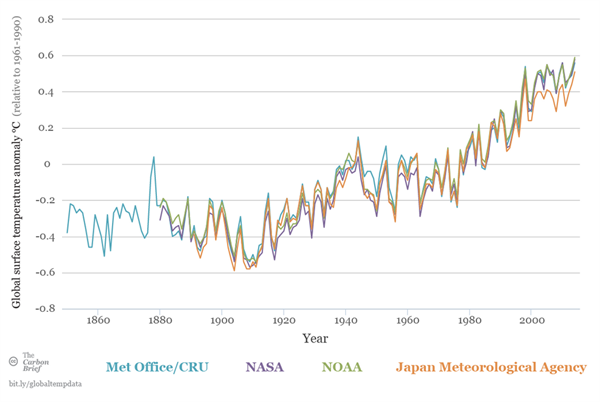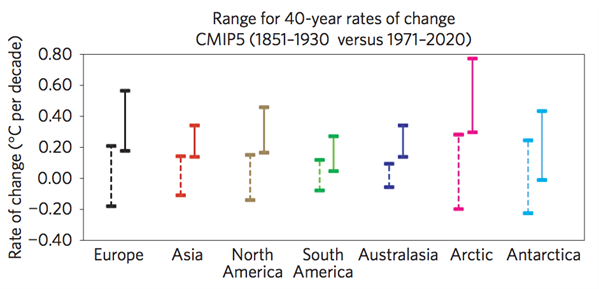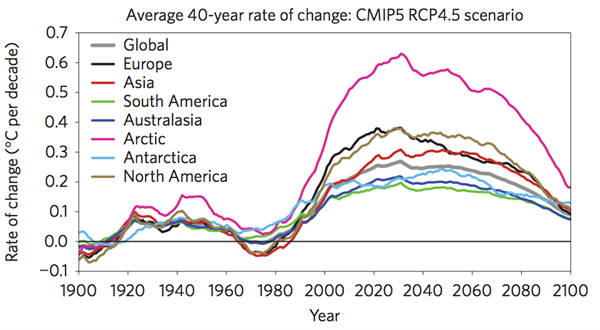Robert McSweeney
09.03.2015 | 4:00pmThe rate of climate change we’re experiencing now is faster than at any time in the last millennium, a new study shows.
Researchers compared how temperature varied over 40-year periods in the past, present and future, and concluded that the Earth is entering a new “regime” of rapid temperature change.
We’re already locked into fast-paced changes in the near future because of past emissions, the researchers say.
That means we’ll need to adapt to minimise the impacts of climate change, even if greenhouse gas emissions are cut substantially.
Peaks and troughs
A look back at how global temperatures have changed over the past century shows how temperature rise of the Earth’s surface has been anything but smooth.
These peaks and troughs are in part caused by natural phenomena, such as volcanic eruptions and El Niño, which influence the Earth’s climate from year to year.
The graph below shows average global surface temperatures for every year back to the 1850s. You can see that temperature changes from decade to decade do not always happen at the same pace. This is the impact of natural cycles in climate, which can either work to enhance or dampen the long-term warming trend over short timescales.
A new study, published in Nature Climate Change, shows how much faster temperature has increased in recent decades compared to any time over the last 1,000 years.
How the major global surface temperature datasets compare. Showing NASA GisTEMP (purple), JMA (orange), NOAA MLOST (green) and Met Office/CRU (blue). Credit: Rosamund Pearce, Carbon Brief
Rate of temperature change
The researchers analysed changes in temperature over 40-year periods, looking at how quickly the temperature rises from one decade to the next. By using 40-year periods, the researchers smooth out the year-to-year ups and downs in order to focus on the influence of human-caused climate change only.
By analysing past temperature records, the researchers found that for the 900 years before the 20th century, rarely any 40-year periods show warming of more than 0.1 degrees per decade.
But when they looked at the second half of the 20th century, the speed of temperature changes increased. Their analysis shows the rate of surface temperature rise in the Northern Hemisphere is now over 0.2 degrees per decade.
Projected trends
The researchers also look at rates of change for the present and near future. Using climate models, they calculated rates of decadal temperature changes for 1971-2020. They then compared them to 1851-1930, before substantial human-caused warming occurred.
The projections are based on an Intergovernmental Panel on Climate Change (IPCC) scenario where global action is taken to limit greenhouse gas emissions. This means it assumes countries around the world will cut back on carbon emissions very quickly, which currently isn’t the case.
The graph below shows the results for each region of the world. Each bar shows the range in results from the climate models, with the solid lines showing 1971-2020 data and the dashed lines showing 1851-1930.
You can see the rates of change are projected to increase for all regions, with the Arctic standing out above the others. Temperatures in the Arctic are currently rising twice as fast as the global average. As Arctic sea-ice diminishes, energy from the sun that would have been reflected away by sea-ice is instead absorbed by the ocean, a phenomenon scientists call Arctic amplification.
Range of past (1851-1930, dashed lines) and near-future (1971-2020, solid lines) regional rates of surface temperature change per decade. Bars show the range of climate model results, based on emission scenario RCP4.5. Source: Smith et al. (2015)
Projections for the rest of the century show average rates of temperature change per decade could reach around 0.4 degrees in Europe and North America, and 0.6 degrees in the Arctic.
But as these results are from a scenario of limited greenhouse gas emissions, the rates could get even higher.
Average rates of regional surface temperature change per decade for the 21st century. Based on emission scenario RCP4.5. Source: Smith et al. (2015)
‘Normal’ is going to keep changing
The results show the Earth’s climate is moving to a new regime where the rate of temperature change is dominated by rising greenhouse gas emissions, the researchers say.
Prof Mat Collins, Joint Met Office Chair in Climate Change at the University of Exeter, says the paper adds more weight to research into recent warming:
“The current rate of global warming over multiple decades, and the expected rate of future warming, has been known to be much faster than anything seen in the last 1,000 years or so. This paper nicely quantifies these rates.”
And the rates are what humans alive today can expect to experience, lead author Dr Steven Smith, a research scientist at the Pacific Northwest National Laboratory, tells Carbon Brief:
“What was ‘normal’ is going to keep changing. It is unlikely that we can avoid most of the changes projected for the next several decades.”
The study highlights the need for humans to adapt, Smith says, but the impacts of an extended period of increasing rates of temperature change are unclear:
“[The need to adapt] is really the bottom line of our study. I don’t believe we know the answer at this point. There are increasing efforts around the world to adapt to climate change. But we also need to better understand which impacts are likely to become important over the next few decades, and then determine how we can best react.”
So tackling climate change is not just about a long-term two degree target, but rapid temperature rise in the near future highlights the need for both mitigation and adaptation.
Smith, S. et al. (2015) Near-term acceleration in the rate of temperature change, Nature Climate Change, doi:10.1038/nclimate2552




